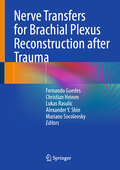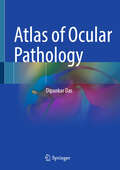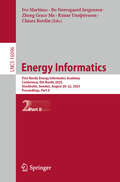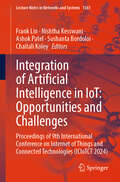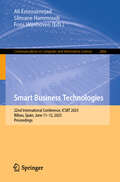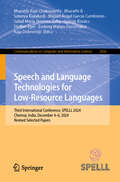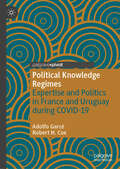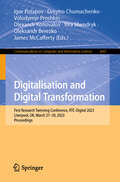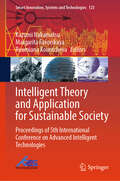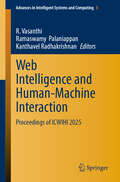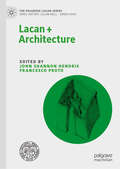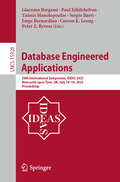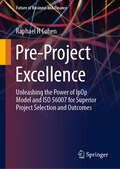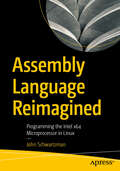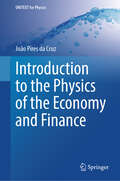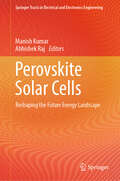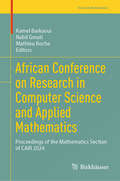- Table View
- List View
Innovative and Responsible Mining for Inclusive Growth: Proceedings, 11th Asian Mining Congress, Kolkata, West Bengal, India, October 30–31, 2025 (Springer Proceedings in Earth and Environmental Sciences)
by Amalendu Sinha Bhabesh Chandra Sarkar Prabhat Kumar MandalCombating the menace of climate change, implementing energy transition and living up to strong societal expectations are serious global concerns. Strangely, the mining activities remain enigmatic to society, though mining footprints are omnipresent in most of our household items as well as in many technological breakthroughs. Thus, the Mining Sector in particular and the Mineral Sector at large have to be more responsible and responsive to make their contribution to nation-building more visible. The stakeholders need to brainstorm to work out the best practices that would recognise them as responsible entrepreneurs. In view of these, The Mining, Geological and Metallurgical Institute of India (MGMI), established way back on 16th January 1906, and one of the oldest institutions of this kind in the world, is organizing the 11th Asian Mining Congress (AMC) during October 30-31, 2025 in Kolkata, India with the Theme, &“Innovative & Responsible Mining for Inclusive Growth&”. The AMC and International Mining Exhibition (IME), held concurrently, are flagship international events organized by MGMI biennially since its centenary year. This series have provided ample opportunities to all stakeholders, including practising engineers, machinery manufacturers, planners, regulators, academicians, scientists and policy makers, for sharing their knowledge, experience and expertise and exhibit their products that can benefit the mining and mineral industries not only in the Asian region but also globally. The proceedings of the 11th AMC comprise insightful articles authored by renowned experts and thought leaders from various disciplines. These contributions highlight recent developments and innovations in the mining sector, aimed at promoting sustainable practices, enhancing technological cooperation, and fostering inclusive growth. This compilation serves as a valuable resource for driving progress in mineral production while exploring new avenues for responsible and sustainable business practices, benefitting both the Asian and global mining communities.
Image and Graphics: 13th International Conference, ICIG 2025, Xuzhou, China, October 31 – November 2, 2025, Proceedings, Part II (Lecture Notes in Computer Science #16162)
by Liang Wang Xin Yu Shiguang Shan Xuesong Wang Zhouchen Lin Jing Dong Risheng Liu Yugang Jiang Shengcai LiaoThe three-volume set constitutes the proceedings of the 13th International Conference on Image and Graphics, ICIG 2025, held in Xuzhou, China, during October 31–November 2, 2025. The 138 full papers presented in this book were carefully selected and reviewed from 420 submissions. These papers have been organized in the following topical sections: Artificial intelligence, Machine learning, Computer vision, pattern Recognition, Rendering, Image manipulation, Graphics systems and interfaces, Image compression, Shape modeling, Biometrics, Scene understanding, Vision for robotics, Scene anomaly detection, Activity recognition and understanding, Feature selection.
Nerve Transfers for Brachial Plexus Reconstruction after Trauma
by Alexander Y. Shin Fernando Guedes Lukas Rasulic Mariano Socolovsky Christian HeinenBrachial plexus injury (BPI) is one of the most functionally devastating injuries, as it causes substantial debilitation and long-term difficulties in daily activities. The burden for the patient and the caregiver may arise not only from neurological disability but also from psychosocial and socioeconomic factors.This injury is more prevalent among young men aged 15 to 25 and is primarily caused by road accidents, especially those involving motorbikes. Other significant causes include obstetric injuries, severe trauma from falls, direct or blunt blows, penetrating injuries, forced traction, and compression injuries.If a nerve has been divided by a sharp laceration, it can usually be repaired with a direct suture. If a nerve tract has been damaged, as is often the case when it has been subjected to severe traction injuries, repair will require a nerve graft. Brachial plexus nerve grafts are typically required for lacerations to achieve a tension-free repair. While neurolysis, nerve repair, and nerve grafting have been employed to address stretching plexus injuries, nerve transfers utilize an undamaged nerve to provide motor input over a relatively short distance to reinnervate a denervated muscle. This approach has become the preferred and most extensively studied technique for nerve repair today, with numerous pathways aiming to enhance functional outcomes. So far, no comprehensive effort has been made to categorize and classify the various nerve transfer techniques and procedures for BPI patients; this is the first book to accomplish that. Neurosurgeons, plastic surgeons, orthopedic surgeons, and hand surgeons must understand and select the most effective methods for treating their BPI patients.
Atlas of Ocular Pathology
by Dipankar DasThis atlas covers a broad spectrum of topics, from congenital anomalies and external eye diseases to conditions affecting the eyelid, conjunctiva, cornea, uvea, lens, retina, vitreous, optic nerve, and orbit. It provides information on both primary and secondary tumors, incorporating the latest American Joint Committee on Cancer (AJCC) classifications. It includes a separate chapter on retinoblastoma and choroidal tumors. The book is illustrated with high-resolution clinical and gross, histopathological, and immunohistochemistry microphotographs to ease decision-making. This book is relevant for practicing ophthalmologists, ophthalmic pathologists, and postgraduate students of ophthalmology as well as optometry and pathology students, and oncology super-specialists.
Energy Informatics: First Nordic Energy Informatics Academy Conference, EIA Nordic 2025, Stockholm, Sweden, August 20–22, 2025, Proceedings, Part II (Lecture Notes in Computer Science #16096)
by Bo Nørregaard Jørgensen Zheng Grace Ma Ivo Martinac Rúnar Unnþórsson Chiara BordinThis book constitutes the proceedings of the First Nordic Energy Informatics Academy Conference, Nordic EIA 2025, which took place in Stockholm, Sweden, in August 2025. The 43 full papers and 8 short papers accepted were carefully reviewed and selected from 65 submissions. They were organized in topical sections as follows: Part I: Energy Forecasting and Intelligent Control Systems; District HEating, Thermal Systems, and Retrofit Strategies; Building Simulation, Urban Energy, and Environmental Sensing; Industrial Process Efficiency and Biomass Utlilzation; Energy Informatics for Electric Vehicles and Mobility Systems; Multi-Agent Systems and Local Market Coordination; Part II: Policy, Metrics, and Infrastructure Performance; Smart Buliding Systems and Semantic Data Integration; Prosumer Optimization and Energy Storage in Local Energy Communities, Grid-Oriented AI, Simulation, and Resilience; Non-Intrusive Load Monitoring and Data Competitions.
Integration of Artificial Intelligence in IoT: Proceedings of 9th International Conference on Internet of Things and Connected Technologies (ICIoTCT 2024) (Lecture Notes in Networks and Systems #1361)
by Ashok Patel Nishtha Kesswani Sushanta Bordoloi Frank Lin Chaitali KoleyThe book is a collection of high-quality research papers presented at 9th International Conference on Internet of Things and Connected Technologies (ICIoTCT 2024), held at National Institute of Technology (NIT) Mizoram, Aizawl, India during 27–28 September 2024. This book presents recent advances on IoT and connected technologies. This book is designed for marketing managers, business professionals, researchers, academicians, and graduate-level students seeking to learn how IoT and connecting technologies increase the amount of data gained through devices, enhance customer experience, and widen the scope of IoT analytics in enhancing customer marketing outcomes.
Artificial Intelligence and Soft Computing: 24th International Conference, ICAISC 2025, Zakopane, Poland, June 22–26, 2025, Proceedings, Part I (Lecture Notes in Computer Science #15948)
by Witold Pedrycz Leszek Rutkowski Marcin Korytkowski Rafał Scherer Ryszard Tadeusiewicz Jacek M. ZuradaThis volume constitutes the proceedings of 24th International Conference on Artificial Intelligence and Soft Computing, ICAISC 2025, Zakopane, Poland, during June 22–26, 2025. The 83 full papers included in this book were carefully reviewed and selected from 163 submissions.They are organized in topical sections as follows: Part I - Neural Networks and Their Applications; Fuzzy Systems and Their Applications; Evolutionary Algorithms and Their Applications. Part II - Computer Vision, Image and Speech Analysis; Data Mining; Pattern Classification and Artificial Intelligence in Modeling and Simulation. Part III - Various Problems of Artificial Intelligence; Agent Systems, Robotics and Control, Bioinformatics, Biometrics and Medical Applications and Concurrent Parallel Processing.
Digital Transformation in Higher Education Institutions (EAI/Springer Innovations in Communication and Computing)
by Silvana Secinaro Maria José Sousa Andreia de Bem Machado Francesca Dal Mas Davide CalandraThis book analyzes digital technologies being used in the teaching-learning process. The authors show how the use of AI in higher education can provide personalized education through the automation of administrative teaching tasks, software programs that favor the detection of topics that need reinforcement in the classroom, the guidance and support of students outside the classroom, and the use of data intelligently to teach and support students. In addition, the authors show how to further personalize education with the use of augmented reality, adaptive platforms, intelligent tutor systems, Chatbots, adaptive learning, computer aided instruction, MOOCs, and robotics. The authors answer questions such as: What sustainable educational technologies can be used in the teaching-learning process; How can Blockchain technology and AI be applied in higher education; How can the metaverse be applied in virtual learning environments? The book is relevant to researchers, professionals, andstudents interested in technology and education.
Smart Business Technologies: 22nd International Conference, ICSBT 2025, Bilbao, Spain, June 11–12, 2025, Proceedings (Communications in Computer and Information Science #2666)
by Ali Emrouznejad Slimane Hammoudi Fons WijnhovenThis book constitutes the conference proceedings of the 22nd International Conference on Smart Business Technologies, ICSBT 2025 held in Bilbao, Spain, during June 11–12, 2025. The 19 full papers included in this book were carefully reviewed and selected from 39 submissions.They focus on the conference theme &“Artificial Intelligence and The Future of GenAI in Business&”, highlighting the transformative potential of Generative AI and its applications in the business world.
Speech and Language Technologies for Low-Resource Languages: Third International Conference, SPELLL 2024, Chennai, India, December 4–6, 2024, Revised Selected Papers (Communications in Computer and Information Science #2656)
by György Kovács Bharathi Raja Chakravarthi Bharathi B Miguel Ángel García Cumbreras Salud María Jiménez Zafra Saranya Rajiakodi Steffen Eger Endang Wahyu Pamungkas Kaja DobrovoljcThis book constitutes the revised selected papers of the Third International Conference on Speech and Language Technologies for Low-Resource Languages, SPELLL 2024, held in Chennai, India, during December 4–6, 2024. The 44 full papers and 11 short papers included in these conference proceedings were carefully reviewed and selected from 120 submissions.They are divided into the following topical sections : Speech Processing and Spoken Language Understanding; Syntax, Semantics and Pragmatics; Advancements in Multilingual NLP: Resources,Processing, and Generation; Multimodality and Language Grounding to Vision and Robotics; Sentiment Analysis and Language-Specific Applications; Misinformation, Bias, and Mental Health Detection; Workshop 1: Workshop on Multimodal Machine Learning in Low-Resource Languages (MMLow 2024);Workshop 2: Workshop on Low Resource Cross Domain, Cross Lingual, Cross Modal Content Analysis –Multimedia and Generative AI; Workshop 3: Workshop on Fake News Detection in Low-Resource Languages.
Political Knowledge Regimes: Expertise and Politics in France and Uruguay during COVID-19 (Studies in the Political Economy of Public Policy)
by Robert H. Cox Adolfo GarcéThis book examines policy responses to Covid-19 in Uruguay and France, in order to shed light on an important new concept in contemporary political science: political knowledge regimes. This concept considers the link between expertise and policymaking, paying particular attention to the demand for scientific knowledge from politicians and policymakers, and why they choose to accept or reject expert advice. The book begins by assessing the interplay between science, expertise and politics in both countries prior to the pandemic. It then explores if and why the recommendations made by experts during the crisis were translated by politicians into actual policies. Whereas in France policymakers followed the advice of scientists throughout the course of the pandemic, there was much divergence in Uruguay. This was due to several important differences, including political culture and the characteristics of political elites. Together, these created very different political knowledge regimes within the two countries. The book concludes by examining political knowledge regimes in other countries and sets out a future research agenda, making it a vital resource for scholars and students around the world. It will appeal to all those interested in public policy, health policy and comparative politics.
The Neuronomicon: A Guide to Acute Neuroradiological Pathology
by Grayson W. HooperThis case-based, high-yield, book is a targeted review of acute neurological problems, including stroke, neurotrauma, and inflammatory conditions. These pressing diagnostic scenarios are based on Dr. Michael Coffey&’s 20-year+ experience in neuroradiology. The book presents residents and fellows with a quick and concise guide to neuroradiology while on call and for board preparation. Each section follows a pattern of presentation that provides a strong foundation of understanding. Bourgeoning neurologists and neurointerventional radiologists will find The Neuronomicon a solid source for focused and general concepts, along with clinical pearls.
Digitalisation and Digital Transformation: First Research Twinning Conference, RTC-Digital 2023, Liverpool, UK, March 27–30, 2023, Proceedings (Communications in Computer and Information Science #2647)
by Igor Potapov Vira Shendryk Dmytro Chumachenko Volodymyr Proshkin Oleksandr Berezko James McCafferty Olexandr KonovalovThis book CCIS 2647 constitutes the refereed proceedings of First Research Twinning Conference on Digitalisation and Digital Transformation, RTC-Digital 2023, held in Liverpool, UK, during March 27–30, 2023. The 29 full papers were carefully reviewed and selected from 101 submissions.The objective is to help Ukrainian academics at Universities and Research institutes to integrate into the international research network and to find new research contacts. In the long term, the high-quality research across the Digital Theme should drive the development of the Digital Infrastructure, Digital Economy and IT sector in Ukraine and support the recent OECD Policy Response "Digitalisation for recovery in Ukraine".
Intelligent Theory and Application for Sustainable Society: Proceedings of 5th International Conference on Advanced Intelligent Technologies (Smart Innovation, Systems and Technologies #123)
by Margarita Favorskaya Kazumi Nakamatsu Roumiana KountchevaThis book includes new research results of scholars from the Fifth International Conference on Advanced Intelligent Technologies (ICAIT 2024) organized by IRNet International Academic Communication Center and IIMT Bhubaneswar, held during November 22–24, 2024. The book covers research work from active researchers who are working on collaboration of industry and various intelligent technologies such as intelligent technologies applicable/applied to manufacturing and distribution of industrial products, factory automation, business, etc. The topics included are all computational intelligence techniques applicable/applied to industry, intelligent techniques in data science applicable/applied to business and management, intelligent network systems applicable/applied to industrial production, intelligent technologies applicable to smart agriculture, and intelligent information systems for agriculture.
Web Intelligence and Human-Machine Interaction: Proceedings of ICWIHI 2025 (Advances in Intelligent Systems and Computing #3)
by R Vasanthi Ramaswamy Palaniappan Kanthavel RadhakrishnanThis book gathers selected research papers presented at International Conference on Web Intelligence and Human-Machine Interaction (ICWIHI 2025), held during 8–9 April 2025 in Salem, Tamil Nadu, India. This book presents a collection of state-of-the-art research work involving cutting-edge technologies in the field of web intelligence and human-machine interaction. It presents original papers that explore the integration of intelligent web technologies with human-cantered design, focusing on areas such as semantic web, web data mining, user interface design, natural language processing, and the development of adaptive, context-aware systems.
Lacan + Architecture (The Palgrave Lacan Series)
by John Shannon Hendrix Francesco ProtoThis book seeks to revise and revive architectural theory through psychoanalysis as well as to apply psychoanalytic theory to architecture. Its authors argue for Lacan’s central importance for a comprehensive theory of building and suggest how architectural theory might offer new resources for psychoanalytic theorists. They address both the perceived crisis in the contemporary state of architecture and architectural theory and crises in society at large, including political and economic fracture and instability and threats to mental health and well-being. It offers fresh insights to architects, architectural educators and practitioners, scholars of psychoanalysis, and anyone interested in the human condition in relation to the built environment.
Database Engineered Applications: 29th International Symposium, IDEAS 2025, Newcastle upon Tyne, UK, July 14–16, 2025, Proceedings (Lecture Notes in Computer Science #15928)
by Yannis Manolopoulos Jorge Bernardino Peter Z. Revesz Carson K. Leung Sergio Ilarri Paul Ezhilchelvan Giacomo BergamiThis LNCS conference volume constitutes the proceedings of 29th International Symposium on Database Engineered Applications, IDEAS 2025, in Newcastle upon Tyne, UK, in July 2025. The 13 full papers and 6 short papers included in this book were carefully reviewed and selected from 30 submissions. They were organized in topical sections as follows: language and models; classification; distributed systems; query answering and education; and data mining.
Pre-Project Excellence: Unleashing the Power of IpOp Model and ISO 56007 for Superior Project Selection and Outcomes (Future of Business and Finance)
by Raphael H CohenThis guide complements traditional project management by focusing on the critical pre-project stage. It addresses a major challenge: only 12% of projects finish on time and within budget, often due to poor initial pre-project analysis. This leads to wasted resources. The content offers proven best practices for implementing ISO 56007 recommendations, enhancing project calibration, selection, and overall success rates. Liberating innovators from the constraints of traditional business plans, the guide suggests, along with ISO 56007, a "Concept/Opportunity Case" as an investor-friendly alternative. This template is rooted in the robust IpOp Decision Tree, an ISO 56007-recommended checklist of 11 fundamental questions to thoroughly address essential decision-makers' concerns. This rigorous method ensures reliable project selection and optimal resource allocation. The IpOp Model serves as a structured roadmap, enabling project managers and innovators to transform ideas into compelling projects. It provides clear guidance for making informed decisions, whether to pivot or abandon projects that aren’t viable. By following ISO 56007 recommendations, the IpOp Model helps navigate uncertainties and manage critical project factors effectively. Ideal for decision-makers, project managers, executives, professionals, intrapreneurs, and entrepreneurs engaged in project management and innovation, this guide is an essential tool for any pre-project analysis and for turning innovative ideas into successful projects.
Assembly Language Reimagined: Programming the Intel x64 Microprocessor in Linux
by John SchwartzmanLearning assembly language won&’t make you a faster programmer. It won&’t enable you to create portable, write-once, run-anywhere programs. So why learn it? The answer is that it will make you a better programmer. Author John Schwartzman takes a fresh look at low-level programming and explores how to write programs using the BIOS and glibc. This laboratory-based book aids the writing of high-level structured programs by showing what the processor can and can&’t do and how it does it. You&’ll take apart high-level structured C/C++ and show what the CPU is doing at every stage of the program. The book introduces programs and activities throughout the development process, providing sample code, makefiles, and shell scripts for each example program. With the help of Assembly Language Reimagined you&’ll become a more capable and versatile computer engineer. What You will Learn Explore a new perspective on the Intel x64 microprocessor for low-level programming Understand what a processor is doing while a high-level structured computer language program is being run Solve problems with the help of software. See why assembly language programming is essential for every serious student of computer science Who This Book Is For Embedded Linux and Assembly developers, engineers and programmers, hobbyists from the Maker community, as well as college and graduate level students who have some prior knowledge of a structured high-level language like C or C++
Languages and Compilers for Parallel Computing: 36th International Workshop, LCPC 2023, Lexington, KY, USA, October 11–13, 2023, Revised Selected Papers (Lecture Notes in Computer Science #14480)
by Henry DietzThis volume LNCS 14480 constitutes the refereed proceedings of the International Workshop, LCPC 2023, in Lexington, KY, USA, held during October 2023. The 10 full papers presented together with 3 short papers were carefully reviewed and selected from 14 submissions. The conference focuses on mobile computing to big data and training of AI systems.
Chinese Computational Linguistics: 24th China National Conference, CCL 2025, Jinan, China, August 11–14, 2025, Proceedings (Lecture Notes in Computer Science #16052)
by Maosong Sun Zhiyuan Liu Ruifeng Xu Weiwei Sun Yubo Chen Zhiliang Tian Peiyong Duan Zhenghao LiuThis book constitutes the refereed proceedings of the 24th China National Conference on Chinese Computational Linguistics, held in Jinan, China, during August 11-14, 2025. The book refers a review of the key topics in Large Language Models, Machine Translation and Multilingual Information Processing, Text Generation, Dialogue and Summarization, Information Retrieval, Text Classification, QA, Language Resource and Evaluation, NLP Applications, ACL ARR Fast Track.
Introduction to the Physics of the Economy and Finance (UNITEXT for Physics)
by João Pires da CruzThe book is the result of some years of teaching a course in Physics Modeling in Economics and Finance to M.Sc. students of Physics/Astrophysics and Eng. Physics. It is devoted to show economics and finance as a part of a physics system by its own right and, with that, to provide students with the basic tools to face a career in finance or in research developing physics models to a very unusual system that we call &“an economy,&” but made of interactions, geometry, equilibrium, and inflation. It goes from understanding the fundamental of basic mathematics to explaining complex systems where it stops working; from the physics&’ meaning of money to derivative valuation; and from statistical physics to the physics of inflationary systems.
Perovskite Solar Cells: Reshaping the Future Energy Landscape (Springer Tracts in Electrical and Electronics Engineering)
by Manish Kumar Abhishek RajPerovskite Solar Cells (PSCs) have shown the significant advancement in the field of photovoltaic technologies, which are transforming the renewable energy landscape through their remarkable efficiency and adaptability. This Book explores the synthesis techniques, characterization, and utilization of perovskite materials, including lead-free alternatives, tandem configurations, and novel strategies for indoor and large area PSCs. Featuring detailed analyses of the fundamental optoelectronic properties, stability issues, and device engineering techniques, this volume offers critical insights into the scientific advancements driving innovations in sustainable and high-performance solar energy solutions. This book serves as vital resource for researchers, materials scientists, and industry professionals interested in the groundbreaking potential of perovskite solar cells in redefining the future of photovoltaics.
African Conference on Research in Computer Science and Applied Mathematics: Proceedings of the Mathematics Section of CARI 2024 (Trends in Mathematics)
by Kamel Barkaoui Mathieu Roche Nabil GmatiThis volume features selected contributions from participants of the 17th African Conference on Research in Computer Science and Applied Mathematics (CARI 2024), held at the University of Béjaïa, Algeria, from November 23-26, 2024. The topics covered include mathematical modelling, stochastic methods, and related fields.
Liouville’s Theory in Linear and Nonlinear Partial Differential Equations (Springer Asia Pacific Mathematics Series #8)
by Takashi SuzukiA variety of theorems named the Liouville property play fundamental roles in modern theory of mathematical analysis. Understanding each of them individually is not so difficult nowadays. What are they pointing toward in their totality, however? This monograph asserts that self-organization may be an answer, searching recent studies on linear and nonlinear partial differential equations. Critical breakthroughs have emerged in accordance with the widely spread classical ideas of J. Liouville in various forms, that is, the spectral, elliptic, surface, and transport theories, in turn. A fusion of them is seen in recently developing research fields—mathematical oncology, non-equilibrium statistical mechanics, dynamical theory, and shape optimization—which taken together may be called the potential for self-organization.


